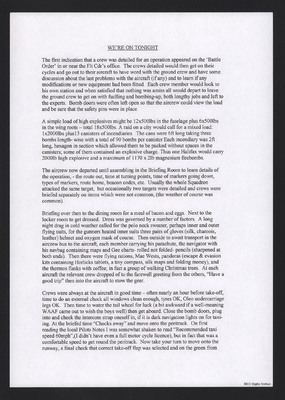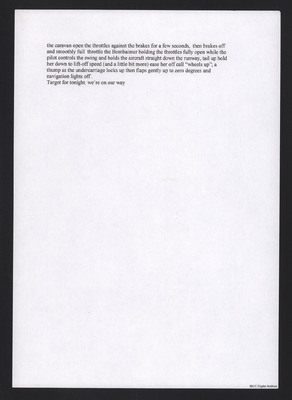We're On Tonight
Title
We're On Tonight
Description
A description of what happened before and during and operation. The battle order was posted, the crew checked over their aircraft, the bomb load was planned, the crew received their briefing, dinner was eaten (bacon and eggs), they dressed, transported to the aircraft and checked everything before finally being ready to take off.
Spatial Coverage
Language
Format
Two typewritten sheets
Publisher
Rights
This content is available under a CC BY-NC 4.0 International license (Creative Commons Attribution-NonCommercial 4.0). It has been published ‘as is’ and may contain inaccuracies or culturally inappropriate references that do not necessarily reflect the official policy or position of the University of Lincoln or the International Bomber Command Centre. For more information, visit https://creativecommons.org/licenses/by-nc/4.0/ and https://ibccdigitalarchive.lincoln.ac.uk/omeka/legal.
Contributor
Identifier
MAllenJH179996-160512-050001,
MAllenJH179996-160512-050002
MAllenJH179996-160512-050002
Transcription
[underlined] WE’RE ON TONIGHT [/underlined]
The first indication that a crew was detailed for an operation appeared on the ‘Battle Order’ in or near the Flt Cdr’s office. The crews detailed would then get on their cycles and go out to their aircraft to have a word with the ground crew and have some discussion about the last problems with the aircraft (if any) and to learn if any modifications or new equipment had been fitted. Each crew member would look to his own station and when satisfied that nothing was amiss all would depart to leave the ground crew to get on with fuelling and bombing-up, both lengthy jobs and left to the experts. Bomb doors were often left open so that the aircrew could view the load and be sure that the safety pins were in place.
A simple load of high explosives might be a 12x500lbs in the fuselage plus 6x500lbs in the wing roots – total 18x500lbs. A raid on a city would call for a mixed load: 1x2000lbs plus 13 canisters of incendiaries. The cans were 6ft long taking three bombs length-wise with a total of 90 bombs per canister. Each incendiary was 2ft long, hexagon in section which allowed them to be packed without spaces in the canisters; some of them contained an explosive charge. Thus one Halifax would carry 2000lb high explosive and a maximum of 1170x2lb magnesium firebombs.
The aircrew now departed until assembling in the Briefing Room to learn details of the operation, - the route out, time at turning points, time of markers going down, types of markers, route home, beacon codes, etc. Usually the whole Squadron attacked the same target, but occasionally two targets were detailed and crews were briefed separately on items which were not common, (the weather of course was common)..
Briefing over then to the dining room for a meal of bacon and eggs. Next to the locker room to get dressed. Dress was governed by a number of factors. A long night drag in cold weather called for the polo neck sweater, perhaps inner and outer flying suits, for the gunners heated inner suits three pairs of gloves (silk, chamois, leather) helmet and oxygen mask of course. Then outside to await transport in the aircrew bus to the aircraft, each member carrying his parachute, the navigator with his navbag containing maps and Gee charts- rolled out not folded- pencils (sharpened at both ends). Then there were flying rations, Mae Wests, pandoras (escape & evasion kits containing Horlicks tablets, a tiny compass, silk maps and folding money), and the thermos flasks with coffee; in fact a group of walking Christmas trees. At each aircraft the relevant crew dropped of (sic) to the farewell greeting from the others, “Have a good trip” then into the aircraft to stow the gear.
Crews were always at the aircraft in good time – often nearly an hour before take-off, time to do an external check all windows clean enough, tyres OK, Oleo undercarriage legs OK. Then time to water the tail wheel for luck (a bit awkward if a well-meaning WAAF came out to wish the boys well) then get aboard. Close the bomb doors, plug into and check the intercom strap oneself in, if it is dark navigation lights on for taxiing. At the briefed time “Chocks away” and move onto the peritrack. On first reading the local Pilots Notes I was somewhat shaken to read “Recommended taxi speed 60mph”, (I didn’t have even a full motor cycle (sic) licence), but in fact that was a comfortable speed to get round the peritrack. Now take your turn to move onto the runway, a final check that correct take-off flap was selected and on the green from
Page break
The caravan open the throttles against the brakes for a few seconds, then breaks off and smoothly full throttle the Bombaimer holding the throttles fully open while the pilot controls the swing and holds the aircraft straight down the runway, tail up hold her down to lift-off speed (and a little bit more) ease her off call “wheels up”; a thump as the undercarriage locks up then flaps gently up to zero degrees and navigation lights off.
Target for tonight, we’re on out way
The first indication that a crew was detailed for an operation appeared on the ‘Battle Order’ in or near the Flt Cdr’s office. The crews detailed would then get on their cycles and go out to their aircraft to have a word with the ground crew and have some discussion about the last problems with the aircraft (if any) and to learn if any modifications or new equipment had been fitted. Each crew member would look to his own station and when satisfied that nothing was amiss all would depart to leave the ground crew to get on with fuelling and bombing-up, both lengthy jobs and left to the experts. Bomb doors were often left open so that the aircrew could view the load and be sure that the safety pins were in place.
A simple load of high explosives might be a 12x500lbs in the fuselage plus 6x500lbs in the wing roots – total 18x500lbs. A raid on a city would call for a mixed load: 1x2000lbs plus 13 canisters of incendiaries. The cans were 6ft long taking three bombs length-wise with a total of 90 bombs per canister. Each incendiary was 2ft long, hexagon in section which allowed them to be packed without spaces in the canisters; some of them contained an explosive charge. Thus one Halifax would carry 2000lb high explosive and a maximum of 1170x2lb magnesium firebombs.
The aircrew now departed until assembling in the Briefing Room to learn details of the operation, - the route out, time at turning points, time of markers going down, types of markers, route home, beacon codes, etc. Usually the whole Squadron attacked the same target, but occasionally two targets were detailed and crews were briefed separately on items which were not common, (the weather of course was common)..
Briefing over then to the dining room for a meal of bacon and eggs. Next to the locker room to get dressed. Dress was governed by a number of factors. A long night drag in cold weather called for the polo neck sweater, perhaps inner and outer flying suits, for the gunners heated inner suits three pairs of gloves (silk, chamois, leather) helmet and oxygen mask of course. Then outside to await transport in the aircrew bus to the aircraft, each member carrying his parachute, the navigator with his navbag containing maps and Gee charts- rolled out not folded- pencils (sharpened at both ends). Then there were flying rations, Mae Wests, pandoras (escape & evasion kits containing Horlicks tablets, a tiny compass, silk maps and folding money), and the thermos flasks with coffee; in fact a group of walking Christmas trees. At each aircraft the relevant crew dropped of (sic) to the farewell greeting from the others, “Have a good trip” then into the aircraft to stow the gear.
Crews were always at the aircraft in good time – often nearly an hour before take-off, time to do an external check all windows clean enough, tyres OK, Oleo undercarriage legs OK. Then time to water the tail wheel for luck (a bit awkward if a well-meaning WAAF came out to wish the boys well) then get aboard. Close the bomb doors, plug into and check the intercom strap oneself in, if it is dark navigation lights on for taxiing. At the briefed time “Chocks away” and move onto the peritrack. On first reading the local Pilots Notes I was somewhat shaken to read “Recommended taxi speed 60mph”, (I didn’t have even a full motor cycle (sic) licence), but in fact that was a comfortable speed to get round the peritrack. Now take your turn to move onto the runway, a final check that correct take-off flap was selected and on the green from
Page break
The caravan open the throttles against the brakes for a few seconds, then breaks off and smoothly full throttle the Bombaimer holding the throttles fully open while the pilot controls the swing and holds the aircraft straight down the runway, tail up hold her down to lift-off speed (and a little bit more) ease her off call “wheels up”; a thump as the undercarriage locks up then flaps gently up to zero degrees and navigation lights off.
Target for tonight, we’re on out way
Collection
Citation
“We're On Tonight,” IBCC Digital Archive, accessed July 27, 2024, https://ibccdigitalarchive.lincoln.ac.uk/omeka/collections/document/16304.
Item Relations
This item has no relations.


